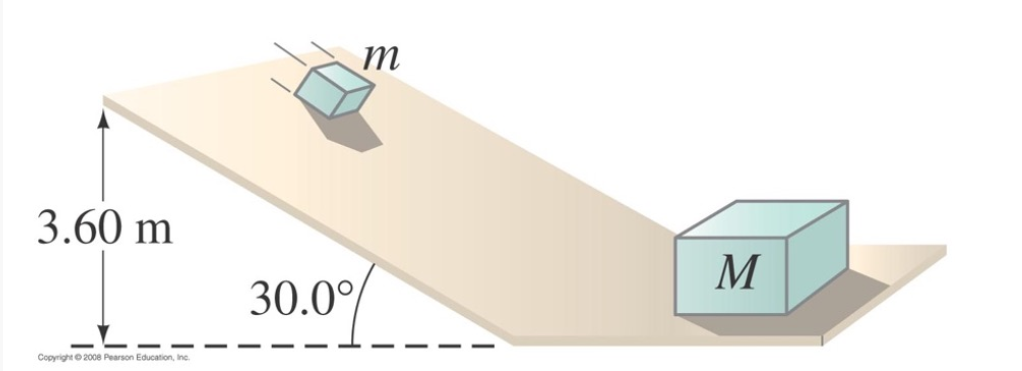A small block of mass m = 3.00 kg starts from rest and slides down a rough 30.0° incline from a height of h=3.60m. The coefficient of kinetic friction between the block and the incline is μk = 0.20. At the bottom it strikes a big block of mass M = 12.0kg, which is at rest on a horizontal frictionless surface. The collision is elastic.
A small block of mass m = 3.00 kg starts from rest and slides down a rough 30.0° incline from a height of h=3.60m. The coefficient of kinetic friction between the block and the incline is μk = 0.20. At the bottom it strikes a big block of mass M = 12.0kg, which is at rest on a horizontal frictionless surface. The collision is elastic.
College Physics
1st Edition
ISBN:9781938168000
Author:Paul Peter Urone, Roger Hinrichs
Publisher:Paul Peter Urone, Roger Hinrichs
Chapter29: Introduction To Quantum Physics
Section: Chapter Questions
Problem 5CQ: Why don't we notice quantization in everyday events?
Related questions
Question
100%
A small block of mass m = 3.00 kg starts from rest and slides down a rough 30.0° incline from a height of h=3.60m. The coefficient of kinetic friction between the block and the incline is μk = 0.20. At the bottom it strikes a big block of mass M = 12.0kg, which is at rest on a horizontal frictionless surface. The collision is elastic.

Transcribed Image Text:m
3.60 m
M
30.0%
Copyright 2008 Pearson Education, Inc.

Transcribed Image Text:A small block of mass m = 3.00 kg starts from rest and slides down a rough 30.0° incline from a height of h=3.60m. The coefficient of kinetic friction
between the block and the incline is pk = 0.20. At the bottom it strikes a big block of mass M = 12.0kg, which is at rest on a horizontal frictionless surface.
The collision is elastic.
A. Find the velocity of the small block at the bottom of the incline before the collision.
B. The velocities of each block after the elastic collision. (If you didn't solve part A, assume a velocity of 8 m/s).
Expert Solution
This question has been solved!
Explore an expertly crafted, step-by-step solution for a thorough understanding of key concepts.
This is a popular solution!
Trending now
This is a popular solution!
Step by step
Solved in 4 steps with 4 images

Knowledge Booster
Learn more about
Need a deep-dive on the concept behind this application? Look no further. Learn more about this topic, physics and related others by exploring similar questions and additional content below.Recommended textbooks for you

College Physics
Physics
ISBN:
9781938168000
Author:
Paul Peter Urone, Roger Hinrichs
Publisher:
OpenStax College

University Physics Volume 3
Physics
ISBN:
9781938168185
Author:
William Moebs, Jeff Sanny
Publisher:
OpenStax

University Physics Volume 1
Physics
ISBN:
9781938168277
Author:
William Moebs, Samuel J. Ling, Jeff Sanny
Publisher:
OpenStax - Rice University

College Physics
Physics
ISBN:
9781938168000
Author:
Paul Peter Urone, Roger Hinrichs
Publisher:
OpenStax College

University Physics Volume 3
Physics
ISBN:
9781938168185
Author:
William Moebs, Jeff Sanny
Publisher:
OpenStax

University Physics Volume 1
Physics
ISBN:
9781938168277
Author:
William Moebs, Samuel J. Ling, Jeff Sanny
Publisher:
OpenStax - Rice University

Physics for Scientists and Engineers: Foundations…
Physics
ISBN:
9781133939146
Author:
Katz, Debora M.
Publisher:
Cengage Learning

